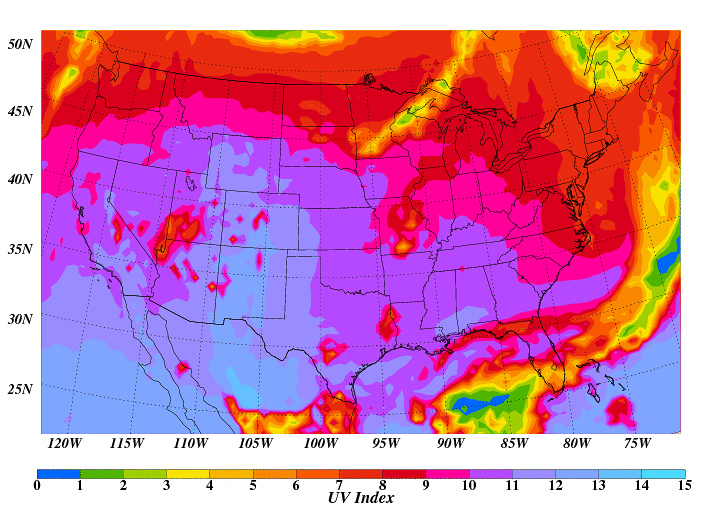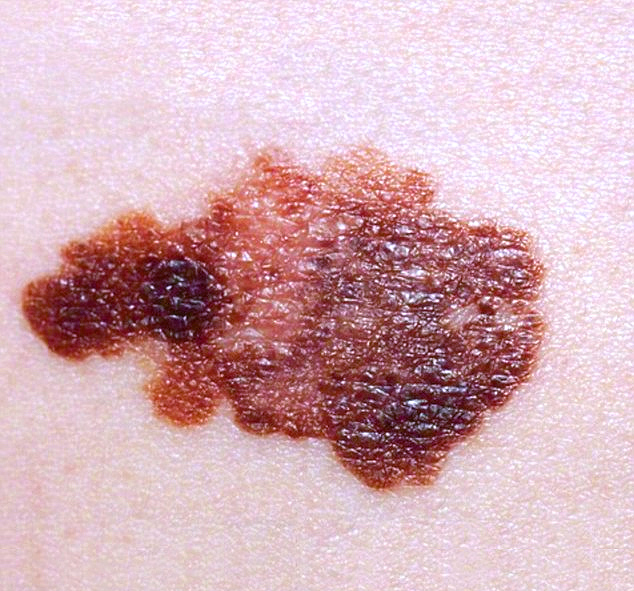The amount of time spent in the sun matters.
When the UV Index is at its highest, such as between June and September for the US, the sun’s rays are at their greatest intensity, which causes the skin to burn in less time. For those with lighter skin, lighter eyes, and even reddish hair, the danger is elevated. Repeatedly burning the skin increases one’s chances of getting melanoma—a very common type of skin cancer. According to the World Health Organization, 1 in 3 cancers diagnosed is skin cancer, while 1 in 5 Americans will develop skin cancer in their lifetime.
The UV Index chart below shows where ultraviolet radiation is the strongest in June for the US. When the UV index is extreme, 10 and higher, skin can burn in just 10 minutes or less.
Overexposure to the sun has adverse health effects.
The health effects of UV radiation include melanoma and nonmelanoma skin cancer, premature aging of the skin, cataracts and other eye damage, and immune suppression. In the summer months, stronger UV rays blanket much of the US with the greatest concentration over southern states, which may have the greatest occurrences of sun exposure-related problems. Even Canada experiences significant exposure during this time.
Protecting your Skin
A productive sunscreen is helpful only if it is reapplied throughout the long summer days while covering your skin or seeking shade, and avoiding the sun altogether are the best solutions overall. Beyond the pain that comes with an uncomfortable and unforgiving sunburn, protecting your skin from the harsh summer sun is important to avoid more dangerous and long-lasting consequences.
Protecting your skin care is a lifelong effort. Therefore, damage to the skin due to sun exposure and cancer risk are both cumulative—the progressive effects of UV exposure over many years. The experts at Providence Saint John’s Health Center and Saint John’s Cancer Institute have weighed in on the matter and provided the following guidance that everyone should follow to protect their skin.
What are some ways to protect yourself from skin cancer?
- Avoid blistering sunburns by using sunscreen. It also is important to avoid the use of tanning beds.
- Use a broad-spectrum sunscreen — at least SPF 30—every two hours when you are in the sun and reapply every half hour if perspiring. If you are just going in and out of the car, you can reapply every four hours. It is important to avoid sunburn at all costs.
- Apply sunscreen as part of your daily routine — brush your teeth, put on deodorant, and put on your sunscreen!
- Wear sun-protection clothing. Rash guards have become a popular option and are great for kids. If you are gardening, for example, or in the sun for a long time, wear a wide-brimmed hat.
- Try to stay out of the sun between 10 a.m. and 4 p.m. when the sun’s rays are the strongest.
- Get yearly skin exams.
What is important for teenagers and young adults to know?
Most of the sun exposure in a person’s life happens before they are 25 years old. It is important to have good sun protection habits from the start.
When should a person start doing skin checks?
It’s encouraged that all adults get a skin check once a year. Unlike screenings such as mammograms and colonoscopies, there is no universal protocol about when to start so try to apply common sense. If you are fair-skinned with red or blond hair, you are at higher risk for UV damage and might want to see a dermatologist in your late teens or early 20s.
What can people do to look out for themselves?
- A = Asymmetry: Does one side of a mole match the other side?
- B = Border: Is it ragged along the edges?
- C = Color: Is it many different colors or shades?
- D = Diameter: Anything above 6 millimeters (the size of a pencil eraser) can be—but isn’t always—worrisome.
- E = Evolution and everything else: Are there any changes in color, size or look of the mole over time?
Dr. Trevan Fischer expalins the ABCDEs of Melanoma
Blog, Video (04:53): Melanoma Awareness: Dr. Trevan Fischer explains the ABCDEs
Get answers from the experts by calling 310-829-8317.
What kind of skin cancer care can Providence Saint John’s provide?
Through a multidisciplinary team approach, the Center for Melanoma, Skin and Soft Tissue Tumors at Saint John’s Cancer Institute provides individualized and compassionate care that is well supported by clinical experts and researchers working together to develop patient-specific treatment plans. The goal is to restore wellness by applying innovative methods and best-practice models that demonstrate improved outcomes for patients. We are a comprehensive melanoma oncology provider with immediate access to scientific research programs.
Learn more about our institute by visiting saintjohnscancer.org/melanoma or contact us at 310-829-8317.
The post Precautions to take as the UV Index Rises appeared first on Saint John’s Cancer Institute Blog.

